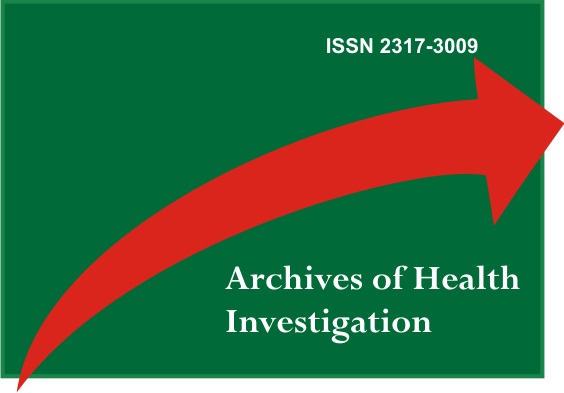Perfil epidemiológico e distribuição demográfica do câncer de língua na região nordeste, Brasil
DOI:
https://doi.org/10.21270/archi.v10i8.5092Keywords:
Mouth Neoplasms, Tobacco, Risk FactorsAbstract
Introduction: The tongue is one of the regions of the oral cavity most affected by malignant neoplasms. In most cases the diagnosis of oral cancer is made late, contributing to the high rates of morbidity and mortality of this disease. Objective: Demonstrate the epidemiological profile and the distribution of the prevalence of cases of tongue cancer in smokers and ex-smokers in the states of northeastern Brazil. Methods: This is a descriptive, cross-sectional epidemiological study, carried out based on data provided by Nacional Cancer Institute through Hospital Cancer Revords, in the last 5 years available. All cases came from the Unified Health System, separated according to sex and history of smoking. The collected data were descriptively analyzed. Results: Data analysis showed that northeastern region registered 1793 cases of tongue cancer. The states of Sergipe, Maranhão, Piaui presented, respectively, the following numbers of neoplasm in the tongue in the las five years: 103(5,7%), 55(3,1%) and 26(2,6%). The state of Paraíba presented a total of 132(7,4%) and Alagoas 136(7,5%). The states of Pernambuco with 651(36,3%) cases, Bahia 489(27,3%) Rio Grande do Norte and Ceará with 173(9,6%), 229(12,8%) simultaneously. The study also showed that 72,4% of individuals are men, and that the hábito of quitting smoking did not prevent the onset of the disease. Conclusion: There is a predominance of the referred lesion in males, brown skin and in smokers. The state of Pernambuco had the highest number of cases of tongue cancer in the northeast region and the state of Piauí had the lowest prevalence.
Downloads
References
Guedes JFA, Lopes JAS, Maciel VW, Nascimento PLA. Neoplasias malignas da língua: um estudo sobre a mortalidade em Pernambuco, PE [monografia]. Caruaru: Centro Universitário Tabosa de Almeida; 2017.
Nóbrega, TD. Avaliação clinicopatológica e sobrevida de pacientes com carcinomas epidermoides de língua, RN [monografia]. Natal: Universidade Federal do Rio Grande do Norte; 2015.
Cavalcanti TR. Prevalência de neoplasias malignas em região oral e maxilofacial oriundas do laboratório de patologia da Universidade Federal do Amazonas: casuística de 30 anos. 2019, AM [dissertação]. Manaus: Universidade Federal do Amazonas; 2019.
Konstantinos H, Roda G, Brygo A, Delaporte E, Colombel JF. Oral Cancer and Oral Precancerous Lesions in Inflammatory Bowel Diseases: A Systematic Review. J Crohn’s Colitis 2015;9(11)1043-52.
Andrade JOM, Santos CAST, Oliveira MC. Fatores associados ao câncer de boca: um estudo de caso-controle em uma população do Nordeste do Brasil. Rev bras epidemiol. 2015;18(4):894-905.
Brasil. Instituto Nacional de Câncer. Falando sobre o câncer de boca [Internet]. 2002 [citado em 7 dezembro 2019]. Disponível em: https://www.inca.gov.br/tipos-de-cancer/cancer-de-boca
Domingos PAS, Passalacqua MLC, Oliveira ALBM. Câncer bucal: um problema de saúde pública Rev Odontol Univ Cid São Paulo, 2014;16(32):18-24.
Pinheiro SMS, Cardoso JP, Prado FO. Conhecimentos e diagnóstico em câncer bucal entre profissionais de Odontologia de Jequié, Bahia. Rev Bras Cancerol. 2010;56(2):195-205.
American Cancer Society. Oral Cavity and Oropharyngeal Cancer [Internet]. 2018 [citado em 19 de janeiro 2020]. Disponivel em: http://www.cancer.org/acs/groups/cid/documents/webcontent/003128-pdf.pdf
Cancer Research UK. Mouth cancer referral guidelines for dentists [internet]. 2010 [citado em 19 de janeiro 2020]. Disponivel em: http://www.cancerresearchuk.org/about-cancer/type/mouth-cancer/about/symptoms-of-mouth--
Dias-Damé JL, Cesar JA, Silva SM.Time trends in smoking in an urban population: a population-based study in Southern Brazil. Cad Saúde Pública, 2011;27(11):2166-74.
Enwonwu, C.O, Meeks V.I. Bionutrition and oral cancer in humans. Crit Rev Oral Biol Med. 1995;6(1):5-17.
Fioretti F, Bosetti C, Tavani A, Franceschi S, La Vecchia C. Risk factor for oral pharyngeal cancer in never smokers. Oral Oncol 1999;35(4):375-78.
Franco SR, Kowalski LP, Oliveira BV, Curado MP, Pereira RN, Silva ME, et al. Risk factors for oral cancer in Brazil: A case-control study. Int J Cancer 1989;43(6):992-1000.
Jerjes W, Upile T, Petrie A, Riskalla A, Hamdoon Z, Vourvachis M et al. Clinicopathological parameters, recurrence, locoregional and distant metastasis in 115 T1-T2 oral squamous cell carcinoma patients. Head Neck Oncol. 2010;2:9.
Gandini S, Botteri E, Lodice S, Boniol H, Lowenfels AB, Maisonneuve P, et al. Tobacco smoking and cancer: a meta-analysis. Int J Cancer. 2008;122(1):155-64.
EUA. MAYO CLINIC. Oral cancer [Internet]. 2019 [Citado em 27 de dezembro 2019]. Dispinível em: http://www.mayoclinic.org/diseases-conditions/mouth-cancer
Maruccia M, Onesti MG, Parisi P, Cigna E, Troccola Um, Scuderi N. Lip cancer: a 10-year retrospective epidemiological study. Anticancer Res. 2012;32(4):1543-46.
Lubin J.H, Purdue H, Kelsey K, Zhang ZF, Winn D, Wei Q et al. Total exposure and exposure rate effects for alcohol and smoking and risk of head and neck cancer: a pooled analysis of case-control studies. Am J Epidemiol. 2009;170(8):937-47.
Moreira MECC. Autopercepção da saúde bucal e ciência dos fatores de risco para câncer oral em idosos. Arq Ciênc Saúde. 2017;24(3):14-18.
Souza JLR, Araújo ACS, Nascimento FSL. O Papel do Farmacêutico na adesão de Pacientes em Uso de Antineoplásico Orais. Estácio Recife. 2019;5(2):1-12.
Instituto Brasileiro de Geografia e Estatística (IBGE). Distribuição da população porcor ou raça, 1999. [Internet]. [Acesso 2019 Ago30]. Disponível em: https://ww2.ibge.gov.br/home/estatistica/populacao/condicaodevida/indicadoresminimos/tabela1.shtm


